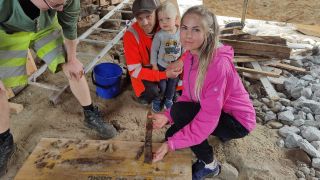Viking sword from warrior's grave unearthed in family's yard in Norway
The Viking Age weapon was discovered by a homeowner clearing land for an extension.

A man digging in his yard to build an extension of his house in southern Norway has unearthed the 1,100-year-old grave of a Viking warrior who was buried with weapons.
The finds include a rusty iron sword in two pieces; its hilt style enabled archaeologists to date the burial to the late 800s or early 900s, during the Viking Age, Joakim Wintervoll — an archaeologist who works for the local government of Agder County, where the relics were found — told Live Science.
"We have a good record of how the 'fashion' in the shapes of sword handles developed in Norway, from early ages up to more modern eras," he said. "Comparing it to other known sword handles, we believe this sword is from the late ninth century to the 10th century."

Other artifacts found in the grave included a long spear designed to be used on horseback, called a lance; glass beads and a belt buckle gilded with gold; and a bronze brooch. Neither human nor animal remains have yet been discovered there.
The artifacts seem to have belonged to a Viking warrior. "The lance suggests that this was someone that was proficient in combat from horseback," Wintervoll said. And the warrior was "definitely someone of means, based on the gold-gilded jewelry."
Related: Double hoard of Viking treasure discovered near Harald Bluetooth's fort in Denmark


Viking burial
The grave and its artifacts were discovered in late June in the yard of a house in the mainly rural district of Setesdal, beside a lake about 125 miles (200 kilometers) southwest of Oslo. Homeowner Oddbjørn Holum Heiland had started using a mechanical digger to clear the spot in his yard where he and his wife Anne planned to extend their house, according to Science Norway.
"I wasn't going to dig a lot, just a little bit in the slope behind the house, to get some more space between the house and the land," he told the news outlet.


He first found an oblong slab just below the surface; it's now been recognized as a gravestone. Further digging revealed the hilt of the sword; Holum Heiland then realized his yard must hold other Viking artifacts, so he stopped digging and called the county archaeologists.
Wintervoll and Jo-Simon Frøshaug Stokke, an archaeologist from Oslo's Museum of Cultural History, visited the site a few days later. No Viking artifacts had been found before at the property, Wintervoll said, but a Viking grave containing a sword, spear, glass beads and a horse bridle were discovered on a nearby farm in the 1930s.
Although it's "a bit too early to say" whether these two graves have a connection, "it is interesting that they are relatively close and have almost identical finds in them," he said.
Ancient claim
It is possible that a Viking warrior was buried at the site as a way for their descendants to claim ownership of the land around it, Wintervoll said. Or, perhaps it had only family significance.
"No grave mound was known to have been on this homestead," Wintervoll said. In Norway, this type of grave is known as a "flatmarksgrav," which translates to "flat field grave," he added.
The person interred there might have been buried whole, or cremated ashes may have been laid down in the grave. "At this point in time, the practice varied a bit from place to place, but we have yet to find any burnt bones," he said.
The grave seems to have been dug on an almost east-west axis, which would align with sunrise and sunset, and the only grave marker seems to have been the oblong stone above it.
"Right now, we don't think this is a grave that was meant to be visible at a great distance," Wintervoll said. "These types of graves might have a more family or private function."
Live Science newsletter
Stay up to date on the latest science news by signing up for our Essentials newsletter.
Tom Metcalfe is a freelance journalist and regular Live Science contributor who is based in London in the United Kingdom. Tom writes mainly about science, space, archaeology, the Earth and the oceans. He has also written for the BBC, NBC News, National Geographic, Scientific American, Air & Space, and many others.
Most Popular

By Tom Metcalfe


By Keith Cooper

By Sascha Pare